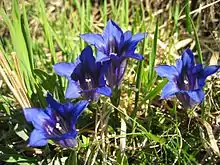Gentiana clusii
Gentiana clusii, commonly known as flower of the sweet-lady or Clusius' gentian, is a large-flowered, short-stemmed gentian, native to Europe. It is named after Carolus Clusius, one of the earliest botanists to study alpine flora.
| Gentiana clusii | |
|---|---|
 | |
| Scientific classification | |
| Kingdom: | Plantae |
| Clade: | Tracheophytes |
| Clade: | Angiosperms |
| Clade: | Eudicots |
| Clade: | Asterids |
| Order: | Gentianales |
| Family: | Gentianaceae |
| Genus: | Gentiana |
| Species: | G. clusii |
| Binomial name | |
| Gentiana clusii E.P.Perrier & Songeon | |
| Synonyms | |
| |
Description
This species is very similar to Gentiana acaulis, but Gentiana clusii differs in the absence of green stripes inside the corolla, by a more pointed shape of the corners between the petals, and preferring areas underlaid by limestone.
Distribution
In common with G. acaulis, Gentiana clusii is found in the Pyrenees, Alps,[1] Apennines, Jura, Black Forest and the Carpathians. Seeds are available from commercial suppliers.
References
- "Description / Gardenplan". www.alpengarten.ch. Retrieved 2021-08-24.
External links
Wikimedia Commons has media related to Gentiana clusii.
This article is issued from Wikipedia. The text is licensed under Creative Commons - Attribution - Sharealike. Additional terms may apply for the media files.